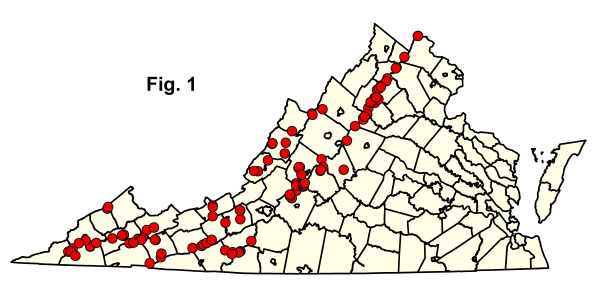
 保育與休閒部
保育與休閒部 保育。保護。享受。
 保育與休閒部
保育與休閒部  目錄
目錄豐富灣森林
The mixed hardwood forests of this group occupy fertile, mesic, mountain-slope habitats at elevations ranging from about 300 m (1,000 ft) commonly to 1,100 m (3,600 ft), and occasionally higher. Distributed locally throughout western Virginia, these forests are strongly associated with moist, sheltered, landforms (i.e., coves, ravines, and concave lower slopes). Soils may be weathered from various substrates but are generally moderately acidic to moderately alkaline, with high base saturation. In these habitats, soil fertility appears to be strongly correlated with high base cation levels (particularly calcium, magnesium, and manganese) rather than with high pH, and higher-elevation sites often have soils with surprisingly low pH. Characteristic trees include sugar maple (Acer saccharum), basswoods (Tilia americana var. americana and var. heterophylla), white ash (Fraxinus americana), tulip-tree (Liriodendron tulipifera), bitternut hickory (Carya cordiformis) and yellow buckeye (Aesculus flava); chiefly south of the James River). Herbaceous growth is lush with spring ephemerals and leafy, shade-tolerant forbs such as blue cohosh (Caulophyllum thalictroides), yellow jewelweed (Impatiens pallida), large-flowered trillium (Trillium grandiflorum), wood-nettle (Laportea canadensis), common black cohosh (Actaea racemosa), sweet cicely (Osmorhiza claytonii), Virginia waterleaf (Hydrophyllum virginianum), large-leaf waterleaf (Hydrophyllum macrophyllum), large-flowered bellwort (Uvularia grandiflora), red trillium (Trillium erectum), yellow violets (Viola pubescens and Viola eriocarpa), white baneberry (Actaea pachypoda), two-leaved miterwort (Mitella diphylla), goat's-beard (Aruncus dioicus var. dioicus,), yellow mandarin (Prosartes lanuginosa), showy skullcap (Scutellaria serrata), eastern blue-eyed-mary (Collinsia verna), Guyandotte beauty (Synandra hispidula), glade fern (Homalosorus pycnocarpos), and many others. Compositional variation related to substrate and elevation is complex but the group partitions convincingly into several major community types. The principal threats to rich cove forests are logging and invasion by shade-tolerant, non-native weeds, especially garlic-mustard (Alliaria petiolata). The frequent to common white ash component of these communities is undergoing widespread mortality from Emerald Ash Borer outbreaks.
Rich Cove 和斜坡森林與類似的基本米西克森林區分為其較有限的山脈分佈、高處的出現在高處;以及花卉組成,其中包含多種主要阿帕拉契亞的高處物種。
參考文獻:庫林和拉溫斯基(1999),弗萊明(1999),弗萊明和庫林(2001),弗萊明和穆爾黑德(1996),弗萊明和穆爾黑德(2000),約翰遜和韋爾(1982),奧爾森和胡普(1986),拉溫斯基等。(1994),拉溫斯基等。(1996),萊因哈特和韋爾(1984)。

此組的分類基於在弗吉尼亞州 34 縣採樣的 119 繪圖的分析(圖。1)。大多數地塊還在國家公園服務局的各種多州區域分類工作中進行分析(例如,國家首都地區和阿帕拉契亞步道植被繪製項目)。需要一些額外的數據收集來確定四種分類型的完整狀態內地理範圍。點擊下面的任何突出顯示的 CEGL 代碼以查看由 NatureReserve 瀏覽器提供的全球 USNVC 描述。

 下載下面列出的每種社群類型的組成摘要統計資料表。
下載下面列出的每種社群類型的組成摘要統計資料表。

